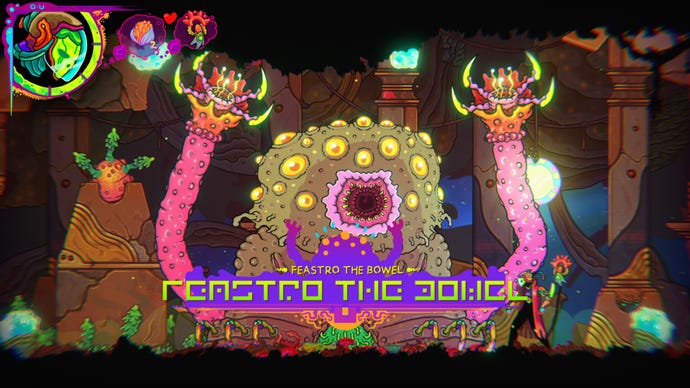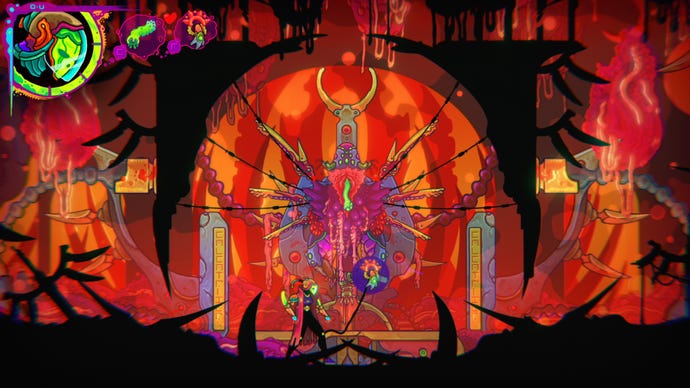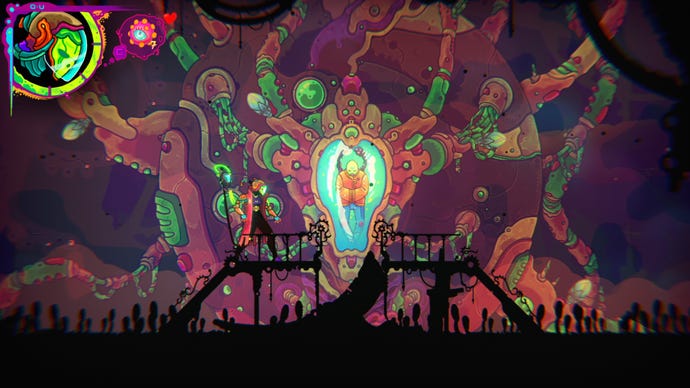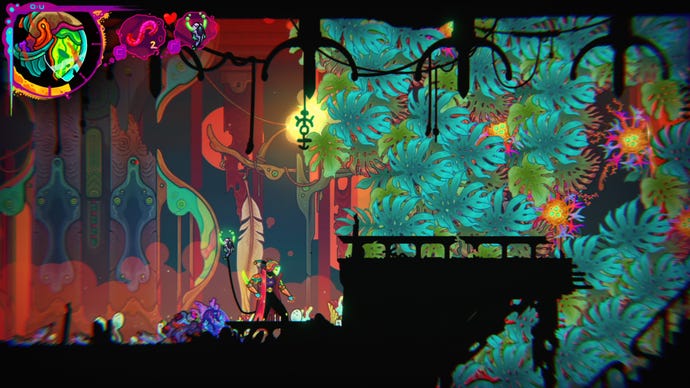Ultros is one of those games that’s born to stick in the memory. Not only is it one of the most visually vibrant games of the year so far with its neon colour palette that’s an instant-KO-to-my-eyeballs, but the way it twists and rewires core tenets of the Metroidvania rulebook also make it one of the boldest and most daring examples of its genre. I’ll say it now: it doesn’t always stick the landing. But if there’s one thing Ultros does constantly throughout its 15-odd hour runtime, it’s that it’s always, always interesting. And for that, it has my respect – even if by the time the (first) end credits rolled, I was ready to never touch it ever again.
To begin with, Ultros is a feast for the senses. As our caped, almost insectoid-like heroine awakens from her slumber in a field of mad, impossible plant life, we gradually learn that we’re trapped in a timeloop on board what is clearly some kind of ship in the vastness of space, but also a place that’s intermittently referred to as both a sarcophagus and cosmic womb. It’s a premise that’s almost as baffling to wrap your head round as its visual frenzy. Whatever this place is, it’s abundant with multi-coloured trees, vines and fungi, and the creatures feasting off its riches feel like they’ve been pulled straight out of some multi-dimensional fever dream.

Everything about your predicament feels constantly on the verge of being too overwhelming to continue, and I suspect there will be plenty of folks who feel that Ultros is ultimately a little high on its own supply. But despite its busy visuals and surreal setup, Ultros is a remarkably easy game to read and navigate thanks the stark black silhouettes outlining its eye-popping backdrops. Moving through Ultros is a breeze in that respect, regardless of whether you’re fully tooled up with your unlockable Cortex abilities, and it grounds the game in a way that make its moment-to-moment platforming feel solid and tangible – even when its plot feels like it’s about to float out the window in a haze of cosmic nonsense.
At the heart of this timeloop is the eponymous demon Ultros, a raging three-eyed purple orb whose true nature and purpose is never fully explored or explained, but is only merely hinted at during the enigmatic encounters you have with the ship’s handful of remaining residents. Some have become more deranged than others thanks to this never-ending time prison, and they’re helpful and violent in equal measure, acting as both bosses who stand in the way of your goal, and guiding hands who occasionally fill your pockets with useful seeds and tools.
Let’s first dissect its combat, which begins as a simple hack and slash affair, but gradually evolves into a cleaner, more precise school of swordplay techniques as you unlock new abilities. It’s never so meticulous that it crosses over into Soulslike territory, but it does actively encourage you to vary your attack strikes and move combos in order to reap better spoils from your foes. These monster gibs don’t just offer better healing bonuses when your health is low, though. They also feed into four coloured bars that unlock new moves. For example, mashing your basic attack over and over will only reward you with a ‘bloody pulp’ that has minimal nutritional benefit, but take down an enemy with three distinct strikes, say, and you might get a ‘perfect’ sample that gives you a much bigger boost. Different abilities require different amounts of these four coloured bars to be filled in (I hesitate to use the word stat bars, as your base stats remain the same throughout), so you’ll need to literally feed your mind so you can grow as a warrior.

To begin with, this tension between healing and personal growth gives Ultros a luminous lick of strategic thinking. Do I power up now, but leave myself with no recovery items? Or do I hold back at the expense of its very good drop-kick, additional combo strikes and sneak attacks? It’s a knotty dichotomy to contemplate, especially when each new timeloop puts you back at square one on the old ability chart. Alas, that edge becomes dulled over time. The more timeloops you go through, the lower each ability’s requirements become, thus requiring fewer nutritious noshes to gain back, and enemies are often such pushovers that you’ll be swimming in limbs and bloodied torsos in no time. Add to this collectible mycelium nodes that let you remember abilities between timeloops, and your incentive to engage with its combat outside boss battles rapidly diminishes.
Even when she’s fully tooled up, though, our heroine can still feel quite stilted and frustrating to control. Wall jumps are fussy to execute with any degree of skill or accuracy, and even her double jumps never feel like they reach as high as they should. Let’s put it this way: she’s a far cry from Ori and Sargon, and feels more akin to Team Cherry’s similarly mysterious Knight. But the chief offender in Ultros’ fussy department is definitely your tethered extractor tool. Like your sword, this is an object you’ll have to manually collect every time you begin a new timeloop, and one whose functions are restored with every new boss you take down. Thankfully, these do persist through each loop, but it’s this – not your Cortex abilities – that makes it possible to reach the farthest corners of the ship. In fact, your Cortex abilities aren’t important at all in the grand scheme of things. They simply give you more options and make things easier when it comes to fights.



The extractor, then, is really what makes this a Metroidvania, but at times it feels so thoroughly busted that you want to throw it back into the void from whence it came. If it’s not the slightly dodgy airborne path-finding of its jet-pack-like Thruster mod, you’ll be pulling your hair out over the tempermental Returner add-on that ‘holds difficult emotions’ (aka: destroys very specific barriers, but only after you’ve defeated a boss and never ever before), or the utterly infuriating Sprayer tool that’s meant to let you manipulate the growth of certain plants, but which ends up feeling like you’re trying to tie a pair of shoelaces that magnetically repel each other. It can be maddening to use at times, and it’s ultimately part of what made me crave the end of Ultros as I reached its final moments.
The biggest reason why I fell of the Ultros wagon, though, was the moment I realised what it would take to reach the game’s actual conclusion. Your goal is to kill off eight Shaman figures who are locked away in a state of deep meditation keeping Ultros at bay, and thus preserving the timeloop for all eternity. Destroying their extravagant sleep pods will therefore break the timeloop and let you escape, albeit at the cost of unleashing this unknowable demon into the world – though due to the vague nature of what Ultros represents, the consequential threat of your actions ends up falling flat. But this, of course, is the violent way of doing things. And really, Ultros is a game about growth, kindness, and tending to one’s spiritual development – a theme that’s hammered home time and again with the seeds you can plant all around the ship in patches of glittering soil.
As each loop advances, these plants will grow and morph over time. Some shoot up tall and straight, with boughs that eventually let you jump up to previously inaccessible ledges. Others let you speed through its long, orange grasses, and the more it spreads, the faster you can steam through its corridors. More still will twist and turn to break down clockwork-like barriers, or grow vines that let you swing across large gaps, and working out which seeds to plant where is all part of Ultros’ wider puzzle. You don’t need to sweat it too much if you end up planting the wrong seed in the wrong place, though. Eventually, your extractor will let you dig out seeds to reuse and plant elsewhere, while chunks of compost can speed up growth cycles without having to go through another timeloop. And I must say, the Digger is one of the extractor’s few delights, as diving into its pulsing, bokeh-flecked soil to find the source of a plant’s roots never fails to entertain.



But your seed count is another thing that resets on the birth of each new loop, and when later areas of the ship demand very specific placement of certain seeds in order to progress, I ended up spending a lot of time simply schlepping about trying to find the right seeds for the job. It’s backtracking at its very worst, and it’s made more tedious by a map that never really makes clear what is and isn’t a viable pathway. Honestly, I think Prince Of Persia: The Lost Crown’s screenshot function may have ruined every future Metroidvania for me on this front, no two ways about it. Did I mention that you have to grow your own fast travel network as well? Oh yes. That’s a whole thing that I’m sure yer ‘games that have fast travel simply don’t have interesting enough travel methods in the first place’ heads will sink their teeth into here. Problem is, Ultros’ travel is quite boring when you don’t have that many reasons to fight anymore, and I’ll admit that connecting it all up requires a level of patience with its finicky extractor tool and seed planning that I simply do not possess – and it’s these processes that lies at the heart of unlocking its true ending as well.
I can see and respect what it’s trying to do, absolutely. But the systems underpinning Ultros’ ambitions simply aren’t up to snuff to deliver them in a way that feels satisfying to play. Unravelling its secrets never quite reaches the same kind of ‘ah ha’ moments as Tunic, for example, nor does its wider machinations feel as brain-meltingly revelatory as Outer Wilds, and I’m not ashamed to admit that I tapped out after seeing just the first version of Ultros’ end credits. Seriously, if you manage to wrangle those connections up its tower of orange Fanta vats, you’re clearly a more adept and patient person than I. It’s such a shame, as fundamentally I do kinda love what Ultros is asking its players to do here. To really see and engage with its environment in such a way that you end up leaving a positive, lasting effect on your surroundings rather than a destructive one, as well as form a relationship with it that attempts to really fix its problems rather than bludgeoning them into submission. That’s why it will always be interesting to me, even if its execution leaves something to be desired. It’s not just its wild, dreamlike looks that make it memorable, but what it tries to achieve in bringing this strange, cosmic world to life in the first place.
This review is based on a retail build of the game, provided by publishers Kepler Interactive.










